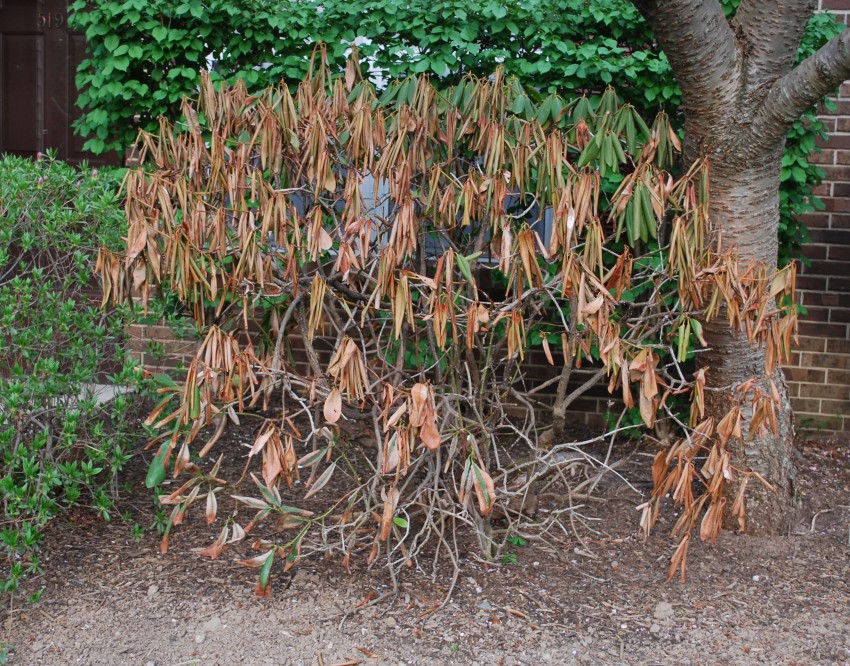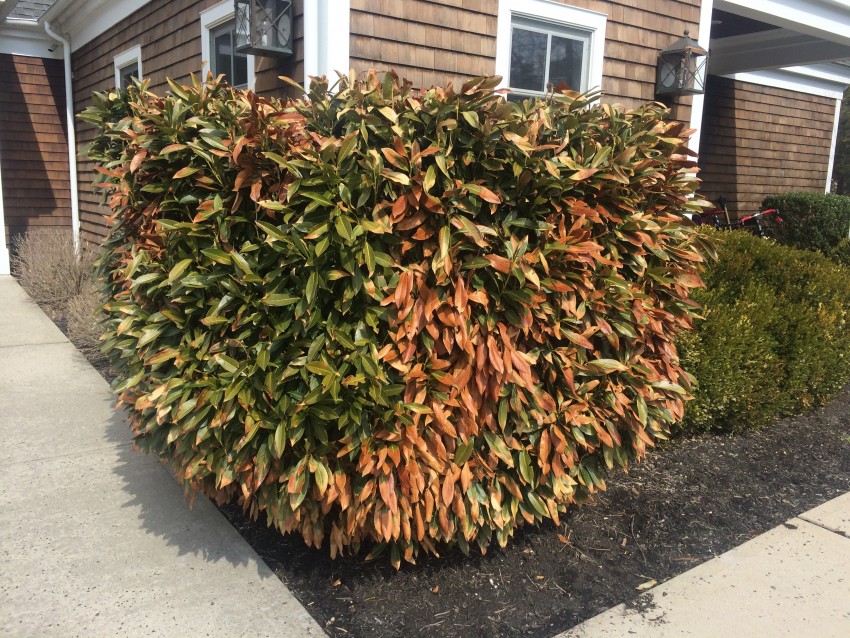Winter’s Toll on the Garden: Is It the Plant or the Weather?
Winter, that fickle guest, has finally packed its bags, leaving behind a landscape that tells a tale of survival. As you step into your garden, you may find rhododendrons with leaves sadly curled, Chamaecyparis looking more brown than golden or green, cherry laurels particularly parched, or other unexpected spring surprises. It’s a gardener’s instinct to assume the worst—pests? Disease? But more often than not, the true culprit is last summer’s relentless drought, autumn’s parched soil, and the icy grip of New England’s winter.
At Burnett’s Country Gardens, we’ve seen it all. We know that a plant’s story doesn’t end with a few brittle branches. Sometimes, patience is all that’s needed to turn a sorry-looking shrub into a triumphant burst of green once more.
A Season of Trials: Drought, Dry Fall & Winter Woes
Last summer was unkind, wasn’t it? Weeks without a decent drop of rain left many plants gasping for moisture. By autumn, they were already weary, their roots desperately seeking what the dry soil could not give. And then came winter, sweeping in with its frozen ground, bone-dry winds, and those teasing warm spells that lured tender buds into waking—only for them to be struck down by the next cruel frost.
Rhododendrons, ever stoic in the garden, suffered quietly through it all. These broadleaf evergreens are resilient, but even they have their limits. In summer, they lose moisture through their leaves under the scorching sun; in winter, the wind robs them just the same. When the ground is frozen, their roots are helpless—unable to draw up the water they so desperately need. And so, they do what they must to survive. Their thick, leathery leaves curl inward, drooping like weary travelers bracing against an unforgiving gale, waiting for warmth to return.
But not all will recover. Some leaves will remain curled and brown, their tips scorched and lifeless. Others may take on a peculiar olive-green hue, a sure sign of struggle. Strangely, two rhododendrons standing side by side may fare differently—one bouncing back with spring’s arrival, the other still bearing the scars of a season too harsh to forget. It is the way of nature, unpredictable yet fascinating.
Here are some of the most affected plants this year…
Broadleaf Evergreens (rhododendrons, boxwoods, hollies, cherry laurel, mt. laurel) – Their leaves, robbed of moisture, crisped at the edges, curled inward, and in some cases, turned an alarming shade of brown. In addition to the leaves, the flower buds or even branches may have been damaged or killed.
Evergreen Conifers (Chamaecyparis, juniper, spruce) – Tip and branch die-back, needle loss
Deciduous Shrubs & Trees (hydrangeas, dogwoods, Japanese maples) – Dehydrated roots meant buds failed before they had a chance to open.

Winter damage to rhododendrons can cause browned leaves and wilted flowers, a common sight after harsh winter conditions. Proper care can help them recover.
Todd’s Winter Garden Woes
Even our owner Todd Burnett, who has spent his life growing and caring for plants, wasn’t spared from winter’s tricks this year. Walking through his yard one morning, he stopped in front of a row of rhododendrons he had planted years ago. Their normally glossy green leaves were curled and lifeless-looking, and for a moment, even he had that sinking feeling every gardener knows: Did I just lose these?
But Todd knows better than to jump to conclusions. He scratched a branch—sure enough, there was green underneath. “Give it time,” he told himself, resisting the urge to start pruning right away. And sure enough, just a few weeks later, small signs of life began to emerge. His patience, just like in years past, paid off.
When in Doubt, Don’t Cut it Out!
It’s easy to assume a plant is lost when it stands there looking like a relic of better days. But wait—spring has only just begun! Plants that are stressed from a long winter are notorious for taking their time, hesitating before sending out new growth. A rhododendron that looks battered in April may surprise you in May or June with fresh leaves. Before you reach for the pruning shears, do a simple test: carefully scratch the bark on limbs in question, it will reveal the plant’s condition. If you find green underneath, the plant is still alive—just biding its time. However, if it appears brown or beige, that branch or twig is likely dead and should be pruned out.
At Burnett’s, we honor our one-year warranty, but we also know that patience often yields better results than replacements. If you’re unsure whether to prune, wait, or replant, stop by with some photos—we’re happy to help assess your garden’s winter survivors.
How to Shield Your Garden from Winter’s Wrath
The best defense against winter damage starts long before the first frost:
-
Water Deeply in Late Fall – A well-hydrated plant is far more resilient. Until temperatures fall under 40, make sure your shrubs and trees get a deep soak before the ground freezes. All new plantings should be soaked thoroughly, every few days.
-
Mulch for Insulation – A thick layer of mulch (2-3 inches of bark, leaves, or pine needles) around the base of plantings protects roots from temperature swings.
-
Provide Wind & Sun Protection – Burlap screens help prevent moisture loss in especially exposed areas. Harsh winter winds, sunny dry days, and dry air all steal precious moisture from the foliage.
-
Skip Late-Season Fertilizing – In general, established trees and shrubs should not be fertilized after late August. We do still recommend amending your soil with a nutrient-rich blend and root stimulator when planting, no matter what time of year.
-
Prune out Dead Parts with Caution – Wait until new growth appears before cutting back damaged branches—what looks dead today may revive tomorrow.
Need a Second Opinion? We’re Here to Help!
If your garden is looking a little worse for wear, don’t despair! Stop by Burnett’s Country Gardens in Salem, CT. Beth, Ingrid, or any of our knowledgeable staff would be happy to help you assess the damage. Whether it’s advice, plant care tips, or simply reassurance that your beloved hydrangea isn’t doomed, we’ve got you covered. After all, in gardening, as in life, patience is often rewarded with the most beautiful surprises.
